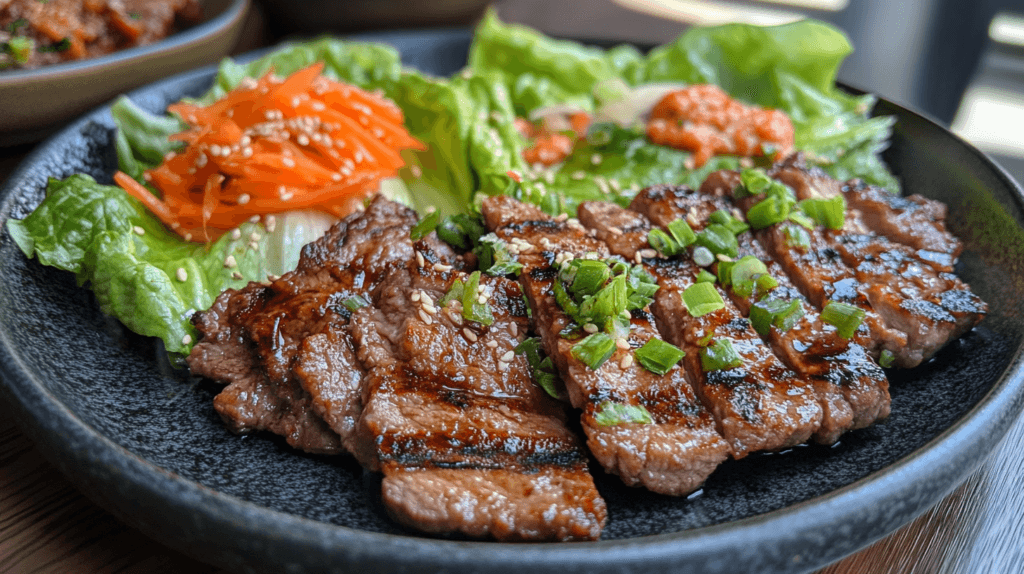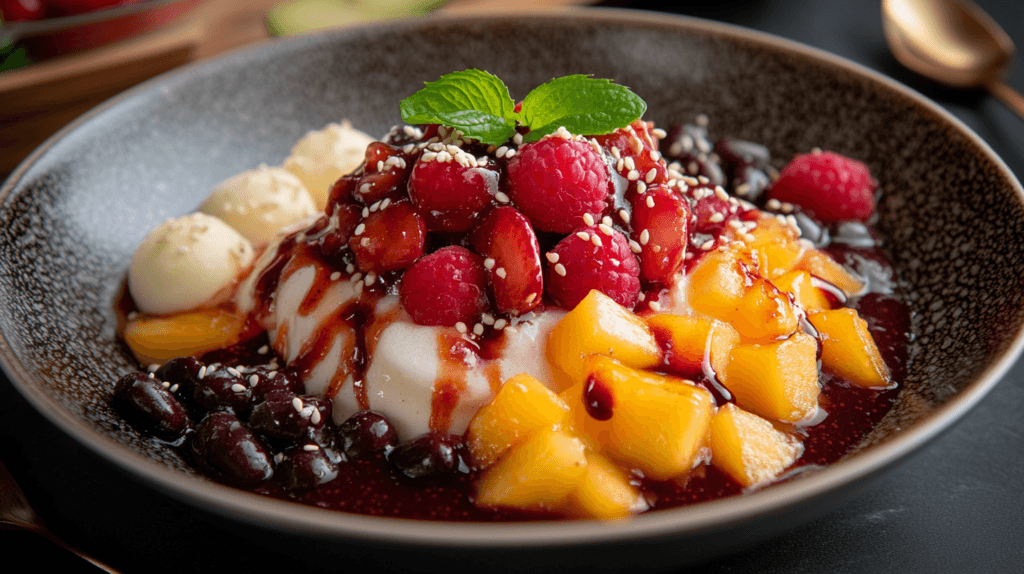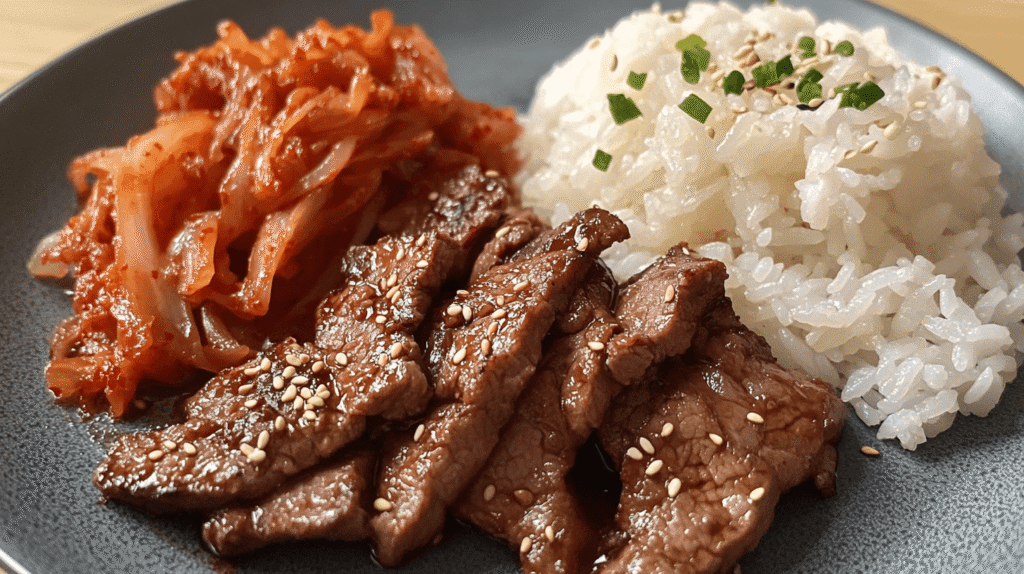Korean cuisine has gained immense popularity worldwide, especially in the United States. Known for its bold flavors, vibrant colors, and balanced nutrition, Korean food offers a unique culinary experience that blends sweet, spicy, savory, and umami flavors. From sizzling Korean BBQ to comforting kimchi stews, every dish reflects Korea’s rich culture and history.
Whether you’re a beginner or an experienced cook, this guide will help you explore authentic Korean Recipes, essential ingredients, and cooking techniques. You’ll also discover the top 5 Korean dishes loved in the USA and how to prepare them at home.
Let’s dive into the world of Korean cooking and bring the flavors of Korea to your kitchen!
Table of Contents
The Essence of Korean Cuisine
Korean food is based on balance and harmony. Every meal includes a variety of textures, flavors, and colors, ensuring a wholesome and satisfying dining experience. Here are some key elements that define Korean cuisine:
1. Bold and Complex Flavors
Korean dishes often combine sweet, salty, sour, spicy, and umami tastes in a single bite. The key to these flavors lies in fermented pastes like gochujang (red chili paste) and doenjang (soybean paste), which add depth and richness to many dishes.
2. Fermentation and Probiotic-Rich Foods
Fermentation plays a crucial role in Korean cuisine, with kimchi being the most famous example. Other fermented foods like doenjang and makgeolli (rice wine) not only enhance flavor but also provide numerous health benefits.
3. Shared Meals and Side Dishes (Banchan)
A traditional Korean meal is rarely served as a single plate. Instead, it includes multiple banchan (side dishes), such as kimchi, seasoned vegetables, and pickled radish, creating a communal dining experience.
4. Rice as a Staple Food
Rice is the foundation of Korean cuisine. Whether steamed, stir-fried, or mixed in dishes like bibimbap, it serves as the perfect base for many meals.
5. Grilled Meats and Barbecue Culture
Korean BBQ is an iconic dining experience where meats like bulgogi (marinated beef) and samgyeopsal (pork belly) are grilled at the table and wrapped in fresh lettuce with condiments.
Essential Korean Ingredients
To cook authentic Korean Recipes, it’s essential to stock up on these ingredients:
1. Gochujang (Korean Chili Paste)
A thick, spicy, and slightly sweet paste made from fermented chili peppers and soybeans. It’s used in dishes like tteokbokki (spicy rice cakes) and bibimbap.
2. Doenjang (Soybean Paste)
A rich, umami-packed fermented soybean paste similar to miso but stronger in flavor. Essential for soups like doenjang jjigae (soybean paste stew).
3. Kimchi
Fermented cabbage or radish with garlic, chili, and fish sauce. A staple side dish in every Korean meal and a key ingredient in dishes like kimchi fried rice.
4. Korean Soy Sauce (Ganjang)
Different from regular soy sauce, Korean soy sauce is often aged longer and has a deeper flavor, perfect for marinades and soups.
5. Sesame Oil
A fragrant oil used for seasoning, dressing, and stir-frying. It adds a rich nutty aroma to dishes like bibimbap and japchae.
6. Korean Rice (Short-Grain Rice)
Sticky and slightly sweet, short-grain rice is the base for many Korean meals.
7. Gochugaru (Korean Chili Flakes)
Sun-dried chili flakes that bring heat and color to kimchi, stews, and stir-fries.
8. Rice Vinegar & Korean Fish Sauce
These are often used for pickling vegetables or enhancing the umami taste in broths.
Having these ingredients in your pantry will help you create authentic Korean flavors in your home-cooked meals.
Traditional Korean Cooking Techniques
Korean cuisine involves various cooking methods that bring out the best flavors in ingredients. Here are the most common techniques used in Korean Recipes:
1. Fermentation
Many Korean staples, like kimchi and doenjang, undergo fermentation, which enhances their taste and nutritional value.
2. Stir-Frying (Bokkeum)
Dishes like kimchi fried rice and japchae (glass noodles with vegetables) use this technique for a quick and flavorful meal.
3. Grilling (Gui)
Meats like bulgogi and samgyeopsal are grilled over an open flame for a smoky, caramelized flavor.
4. Stewing (Jjigae & Guk)
Rich stews like kimchi jjigae and doenjang jjigae are simmered slowly to develop deep, comforting flavors.
5. Boiling (Juk & Tang)
Soups like seolleongtang (ox bone soup) and samgyetang (ginseng chicken soup) are made by boiling bones and ingredients for hours to extract maximum nutrients.
By mastering these cooking techniques, you can recreate Korean dishes just like in a traditional Korean kitchen.
Classic Korean Appetizers (Banchan)
In Korean cuisine, banchan (side dishes) are small, flavorful dishes served alongside rice and the main meal. These appetizers add variety, texture, and balance to any Korean feast.
1. Kimchi (Fermented Spicy Cabbage)
Kimchi is Korea’s most famous banchan, made from fermented napa cabbage and radish, seasoned with gochugaru (Korean chili flakes), garlic, ginger, and fish sauce. It provides a spicy, tangy kick that complements any meal.
👉 How to Make Quick Kimchi:
- Chop napa cabbage into bite-sized pieces and salt them for 1-2 hours.
- Rinse and drain the cabbage.
- Mix with a paste made of gochugaru, garlic, ginger, fish sauce, and sugar.
- Store in a jar at room temperature for a day, then refrigerate.
2. Kongnamul Muchim (Seasoned Soybean Sprouts)
A simple yet refreshing banchan made from boiled soybean sprouts, garlic, sesame oil, and salt. It has a mild nutty flavor and is a great side dish for BBQ.
3. Gamja Jorim (Braised Potatoes)
Small potatoes simmered in soy sauce, sugar, and sesame oil until tender and slightly caramelized. This sweet-savory dish is a favorite among children and adults.
4. Pajeon (Korean Scallion Pancakes)
A crispy pancake made with flour, eggs, scallions, and seafood. It is pan-fried to golden perfection and served with a dipping sauce of soy sauce, vinegar, and chili flakes.
👉 Quick Recipe:
- Mix flour, water, eggs, and salt into a batter.
- Stir in chopped scallions and optional seafood.
- Pan-fry until golden brown and crispy.
- Serve with a soy dipping sauce.
Must-Try Korean Soups and Stews
Korean cuisine is known for its hearty and nourishing soups that are perfect for any season. Here are some of the most popular ones:
1. Kimchi Jjigae (Kimchi Stew)
A spicy and tangy stew made with aged kimchi, tofu, pork (or tuna), and gochujang. This comforting dish is packed with deep umami flavors.
2. Doenjang Jjigae (Soybean Paste Stew)
A rich, earthy stew made from doenjang (fermented soybean paste), tofu, zucchini, and mushrooms. It’s often compared to miso soup but with a stronger flavor.
3. Samgyetang (Korean Ginseng Chicken Soup)
A healthy, immune-boosting soup made with a whole young chicken stuffed with glutinous rice, garlic, jujube (red dates), and ginseng, simmered in a light broth.
4. Seolleongtang (Ox Bone Soup)
A milky, collagen-rich broth made by simmering beef bones for several hours. It’s often served with salt, scallions, and rice noodles for a simple yet nourishing meal.
Top 5 Korean Recipes Eaten in the USA and How to Prepare Them

Korean food has become incredibly popular in the United States, thanks to its bold flavors, variety, and health benefits. Here are the top 5 most loved Korean dishes in the USA and how you can make them at home:
1. Bulgogi (Korean Marinated Beef BBQ)
A classic Korean BBQ dish, bulgogi features thinly sliced beef marinated in a sweet and savory soy-based sauce.
👉 How to Make Bulgogi:
- Slice beef (ribeye or sirloin) thinly.
- Marinate with soy sauce, brown sugar, sesame oil, garlic, and pear juice (for tenderness).
- Let it sit for at least 30 minutes.
- Grill or pan-fry on high heat until caramelized.
- Serve with rice and lettuce wraps (ssam).
2. Bibimbap (Mixed Rice Bowl with Vegetables and Egg)
A vibrant, nutritious dish featuring steamed rice, assorted vegetables, marinated beef, and a fried egg. It’s served with gochujang sauce for extra spice.
👉 How to Make Bibimbap:
- Cook short-grain rice and set aside.
- Sauté assorted vegetables (spinach, carrots, mushrooms, zucchini).
- Cook marinated beef (bulgogi-style).
- Fry an egg sunny-side up.
- Assemble rice, toppings, and gochujang sauce in a bowl.
3. Kimchi Fried Rice (Kimchi Bokkeumbap)
A quick and easy comfort food made with leftover rice, kimchi, and eggs.
👉 How to Make Kimchi Fried Rice:
- Heat sesame oil in a pan and sauté kimchi until fragrant.
- Add cold rice and stir-fry.
- Season with soy sauce, gochujang, and a little sugar.
- Top with a fried egg and sesame seeds.
4. Tteokbokki (Spicy Rice Cakes)
A chewy, spicy, and slightly sweet street food dish made with rice cakes, fish cakes, and gochujang sauce.
👉 How to Make Tteokbokki:
- Boil water or anchovy broth in a pan.
- Add gochujang, soy sauce, sugar, and garlic.
- Stir in rice cakes and fish cakes.
- Simmer until the sauce thickens and the rice cakes become soft.
5. Korean Fried Chicken (Crispy Sweet-Spicy Chicken)
Korean fried chicken is double-fried for extra crunch and coated in a sweet, spicy glaze.
👉 How to Make Korean Fried Chicken:
- Coat chicken pieces in cornstarch and flour.
- Double-fry in hot oil until crispy.
- Toss in a sauce made of gochujang, honey, garlic, and soy sauce.
- Garnish with sesame seeds and enjoy!
Popular Korean Street Foods
Korean street food is famous for its bold flavors, affordability, and convenience. Whether you’re strolling through the streets of Seoul or visiting a Korean market in the USA, these must-try street foods will leave you craving more.
1. Hotteok (Sweet Korean Pancakes)
Hotteok is a crispy-on-the-outside, chewy-on-the-inside pancake filled with a sweet mixture of brown sugar, cinnamon, and chopped nuts.
👉 How to Make Hotteok:
- Prepare a yeast-based dough and let it rise.
- Flatten the dough and place a brown sugar-cinnamon filling inside.
- Pan-fry until golden brown and caramelized.
2. Odeng (Fish Cake Skewers in Broth)
Odeng, or eomuk, is a popular skewered fish cake dish served in a light, savory broth.
👉 How to Make Odeng:
- Boil anchovy broth with soy sauce and garlic.
- Skewer fish cakes and simmer in the broth for a few minutes.
- Serve hot with dipping sauces.
3. Kimbap (Korean Rice Rolls)
Often called “Korean sushi,” kimbap is made with seasoned rice, vegetables, and sometimes meat or fish, rolled in seaweed.
👉 How to Make Kimbap:
- Lay a seaweed sheet on a sushi mat.
- Spread seasoned rice evenly.
- Add fillings like cooked carrots, spinach, eggs, and pickled radish.
- Roll tightly and slice into bite-sized pieces.
4. Korean Corn Dogs
Unlike American corn dogs, Korean corn dogs are coated in a thick batter, sometimes covered in potatoes or breadcrumbs, and deep-fried.
👉 How to Make Korean Corn Dogs:
- Skewer hot dogs or mozzarella cheese.
- Dip in a batter made of flour, eggs, and sugar.
- Coat with breadcrumbs or diced potatoes.
- Deep-fry until crispy and golden brown.
- Sprinkle with sugar and drizzle with ketchup or mustard.
Vegetarian and Vegan Korean Recipes
Korean cuisine has many dishes that can be easily adapted for a plant-based diet. Here are some delicious vegetarian Korean Recipes you can try at home.
1. Vegan Bibimbap
A fully plant-based version of the classic bibimbap, loaded with vegetables and a flavorful gochujang sauce.
👉 How to Make Vegan Bibimbap:
- Cook steamed rice and set aside.
- Sauté a variety of vegetables (carrots, mushrooms, spinach, zucchini).
- Replace meat with tofu or tempeh.
- Top with vegan gochujang sauce and sesame seeds.
2. Dubu Jorim (Braised Tofu in Soy Sauce)
A spicy, flavorful tofu dish simmered in soy sauce, garlic, and gochugaru.
👉 How to Make Dubu Jorim:
- Slice firm tofu and pan-fry until golden.
- Simmer in a sauce made of soy sauce, garlic, gochugaru, and sesame oil.
3. Kimchi (Vegan Version)
Most kimchi contains fish sauce, but you can make a vegan version using kombu (seaweed) or soy sauce instead.
👉 How to Make Vegan Kimchi:
- Salt napa cabbage and let it sit for a few hours.
- Rinse and mix with a paste of gochugaru, garlic, ginger, soy sauce, and sugar.
- Ferment for a few days to a week before eating.
Traditional Korean Desserts

Korean sweets are often not overly sugary and feature ingredients like red bean paste, rice flour, and honey.
1. Bungeoppang (Fish-Shaped Pastry with Sweet Red Bean Filling)
A crispy, fish-shaped waffle filled with sweet red bean paste or custard.
2. Patbingsu (Shaved Ice with Sweet Toppings)
A popular summer dessert made with shaved ice, condensed milk, sweet red beans, and fruit toppings.
3. Yakgwa (Honey Cookies)
A traditional Korean deep-fried cookie made with honey, sesame oil, and cinnamon.
Korean Drinks and Beverages
Korean cuisine includes a variety of unique drinks, from alcoholic beverages to refreshing teas.
1. Soju (Korea’s Most Popular Alcoholic Drink)
Soju is a clear, slightly sweet Korean spirit often paired with BBQ and spicy dishes.
2. Makgeolli (Korean Rice Wine)
A slightly carbonated, milky rice wine with a mildly sweet and tangy flavor.
3. Sikhye (Sweet Rice Punch)
A refreshing dessert drink made with fermented rice, barley malt, and sugar.
4. Barley Tea (Bori-cha)
A caffeine-free toasted barley tea, served hot or cold as a daily drink in Korea.
Tips for Cooking Korean Food at Home
Cooking Korean food at home is easy and rewarding with these essential tips:
✔ Stock Up on Korean Pantry Staples – Keep gochujang, doenjang, sesame oil, and kimchi on hand.
✔ Use Fresh Ingredients – Korean dishes emphasize fresh vegetables, meats, and seafood.
✔ Balance Flavors – Aim for the perfect sweet, salty, spicy, and umami balance.
✔ Marinate Meats Properly – Let meats sit in marinades for at least 30 minutes to absorb flavor.
✔ Cook Rice Properly – Use short-grain rice and rinse it before cooking for the best texture.
Frequently Asked Questions (FAQs)
1. What is the most popular Korean dish in the USA?
Bulgogi and Korean Fried Chicken are the most popular Korean dishes in the USA.
2. Can I make Korean food without gochujang?
Yes, but gochujang gives many dishes their authentic flavor. You can substitute with Sriracha + miso paste + honey for a similar taste.
3. What’s the difference between Korean BBQ and American BBQ?
Korean BBQ typically features thinly sliced, marinated meats cooked at the table, while American BBQ is more about slow-cooked, smoked meats. Both are flavorful but distinctly different in preparation and taste. If you’re a fan of grilled flavors, explore our ultimate guide to grilled recipes.
4. How do I make Korean food less spicy?
Reduce the amount of gochujang and gochugaru, and add more honey or sugar for balance.
5. What’s the best Korean dish for beginners to cook?
Bibimbap and Kimchi Fried Rice are easy to make and require simple ingredients.
6. Where can I buy Korean ingredients?
You can find them at Asian grocery stores, Korean supermarkets like H Mart, or online on Amazon.
Conclusion
Korean cuisine is full of bold flavors, diverse textures, and rich cultural traditions. Whether you’re making Bulgogi, Bibimbap, or Tteokbokki, each dish brings a taste of Korea into your home.
By exploring Korean recipes, you can enjoy restaurant-quality meals without leaving your kitchen. So grab your ingredients, fire up your stove, and start cooking delicious homemade Korean food today! If you’re looking for more inspiration, check out our collection of fusion recipes.

